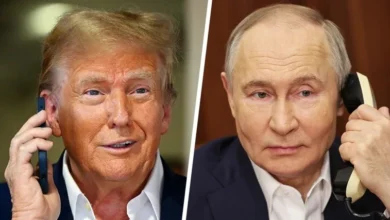From retail to tech, here are the 10 corporations that recently announced mass layoffs

Amid widespread economic uncertainty, some analysts said companies are at a standstill. This has caused many to limit new work to only a few specific roles, if not stop openings entirely. At the same time, some large layoffs continued to pile up, raising concerns among workers across sectors.
Some companies pointed to higher operating costs spilling over from president Donald Trump’s barrage of new tariffs and shifts in consumer spending. Others cite broader corporate restructuring — or, as we’ve seen with big names like Amazon, redirecting money into investments like artificial intelligence.
In such cases, “it’s not just the AI directly taking jobs, it’s the AI’s appetite for money that may be taking jobs,” said Jason Schlozer, a business professor at Georgetown University’s McDonough School. He pointed to the broader “trade-offs” from employment to infrastructure investment that companies are seeing today.
Federal employees faced additional doses of uncertainty, which affected workers’ sentiment about the labor market overall. Shortly after Trump returned to office at the beginning of the year, federal jobs were cut by the thousands. Many workers are now living without pay as the US government shutdown approaches its fourth week.
“A lot of people are looking around, looking at the work environment, looking at the opportunities available to them — whether it’s in the public or private sector,” Schlozer said. “And I think there’s a question mark about long-term stability everywhere.”
Government employment data remained pending during the lockdown, but earlier this month a survey by payroll company ADP showed a surprise loss of 32,000 private sector jobs in September.
Here are some companies that have moved to cut jobs recently.
Amazon
Amazon said Tuesday it will cut about 14,000 jobs at the company, roughly 4% of its workforce, as the online retail giant ramps up spending on artificial intelligence while cutting costs elsewhere. Most workers will be given 90 days to search for a new job internally, a letter to employees said.
CEO Andy Jassy previously said he expects productive AI to reduce Amazon’s workforce in the coming years. It has been aggressively cutting costs overall since 2021.
UPS
United Parcel Service has cut about 34,000 jobs since the beginning of this year as part of its turnaround efforts, amid broader shifts in the company’s shipping output.
The layoffs, disclosed in a regulatory filing Tuesday, are significantly higher than the roughly 20,000 cuts UPS expected earlier this year. UPS said Tuesday that it also closed indoor daily operations at 93 leased and owned buildings during the first nine months of this year.
goal
Last week, it targeted cutting about 1,800 jobs at the company, or about 8% of the companies’ global workforce.
Target said the cuts were part of a broader simplification effort — with Michael Fedelke, chief operating officer, noting that “a lot of layers and overlapping work slowed down decisions.” The retailer is also looking to rebuild its customer base. Target has reported flat or declining comparable sales in nine of the past eleven quarters.
Nestle
In mid-October, Nestlé said it would cut 16,000 jobs globally – as part of broader cost cuts aimed at reviving its financial performance.
The Swiss food giant said the layoffs will take place over the next two years. The cuts come as Nestlé and others face headwinds such as rising commodity costs and tariffs imposed by the United States. The company announced price increases during the summer to compensate for the rising costs of coffee and cocoa.
Lufthansa Group
In September, the Lufthansa Group said it would eliminate 4,000 jobs by 2030 — a nod to the adoption of artificial intelligence, digitalization, and work standardization among member airlines.
The company said that most of the jobs lost will be in Germany, and the focus will be on administrative, not operational, roles. The layoff plans arrived even as the company reported strong demand for air travel and forecast stronger earnings in the coming years.
Novo Nordisk
Also in September, Danish pharmaceutical company Novo Nordisk said it would cut 9,000 jobs, about 11% of its workforce.
Novo Nordisk – which makes drugs such as Ozempic and Wegovy – said the layoffs were part of a broader restructuring as the company works to sell more obesity and diabetes drugs amid increased competition.
ConocoPhillips
Oil giant ConocoPhillips said it plans to lay off up to a quarter of its workforce, as part of the company’s broader efforts to cut costs.
A ConocoPhillips spokesperson confirmed the layoffs on September 3, noting that 20% to 25% of the company’s employees and contractors would be affected worldwide. At the time, ConocoPhillips had a total employee count of about 13,000 — or between 2,600 and 3,250 workers. Most of the cuts were expected to take place before the end of 2025.
Intel
Intel has moved to shed thousands of jobs – as the struggling chipmaker works to revive its business as it falls behind rivals such as Nvidia and Advanced Micro Devices.
In a July memo to employees, Intel CEO Lip Bo Tan said Intel expects to end the year with 75,000 “essential” workers, excluding subsidiaries, through layoffs and attrition. That’s down from the 99,500 essential employees reported at the end of last year. The company had previously announced a 15% reduction in the workforce.
Microsoft
In May, Microsoft began laying off about 6,000 workers in its workforce. A few months later, the tech giant announced it would cut 9,000 jobs, the largest round of layoffs in more than two years.
The latest job cuts have hit Microsoft’s Xbox video game business and other divisions. The company has cited “organizational changes,” with several executives describing the layoffs as part of a drive to trim layers of management. But the labor cuts also come as the company spends heavily on artificial intelligence.
Procter & Gamble
In June, Procter & Gamble said it would cut up to 7,000 jobs over the next two years, 6% of the company’s global workforce.
The maker of Tide detergent and Pampers diapers said the cuts were part of a broader restructuring exercise – which also arrived amid tariff pressures. In July, P&G said it would raise prices on about a quarter of its products because of newly imposed import taxes, though it has since said it expects to take a smaller hit than previously expected for fiscal 2026.
2025-10-28 20:04:00




